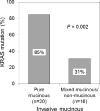Associations between mutations and histologic patterns of mucin in lung adenocarcinoma: invasive mucinous pattern and extracellular mucin are associated with KRAS mutation
- PMID: 25029118
- PMCID: PMC4666292
- DOI: 10.1097/PAS.0000000000000246
Associations between mutations and histologic patterns of mucin in lung adenocarcinoma: invasive mucinous pattern and extracellular mucin are associated with KRAS mutation
Abstract
Multiple reports indicate that epidermal growth factor receptor (EGFR) mutations are associated with lepidic-pattern lung adenocarcinoma and that KRAS mutations are associated with invasive mucinous adenocarcinoma. We sought to investigate the association between EGFR and KRAS mutations and specific morphologic characteristics, such as predominant histologic subtype and mucinous features. Clinical data for 864 patients with resected lung adenocarcinoma that underwent molecular testing for EGFR and KRAS mutations were collected. Histologic subtyping was performed according to the IASLC/ATS/ERS lung adenocarcinoma classification, with attention given to signet-ring cell feature and extracellular mucin. EGFR mutations were detected using a polymerase chain reaction-based sizing assay, KRAS mutations were detected using Sanger sequencing, and ALK expression was detected using immunohistochemistry. Invasive mucinous adenocarcinoma was associated with KRAS mutation (P<0.001). Among invasive mucinous adenocarcinomas with KRAS mutation, a pure mucinous pattern was more common than a mixed mucinous/nonmucinous pattern (P=0.002). Invasive mucinous adenocarcinoma was associated with KRAS transition mutations (G→A) but not transversion mutations (G→T or G→C) compared with nonmucinous tumors (P=0.009). The lepidic-predominant group was associated with EGFR mutation compared with nonlepidic-predominant tumors (P=0.011). Extracellular mucin was associated with KRAS mutation (P<0.001), whereas signet-ring cell feature was not associated with EGFR or KRAS mutation (P=0.517). ALK expression was associated with signet-ring cell feature (P=0.001) but not with extracellular mucin (P=0.089). Our study shows that histologic patterns of mucin in lung adenocarcinoma-including invasive mucinous adenocarcinoma and extracellular mucin-are associated with KRAS mutation.
Conflict of interest statement
Figures





References
-
- Lynch TJ, Bell DW, Sordella R, et al. Activating mutations in the epidermal growth factor receptor underlying responsiveness of non-small-cell lung cancer to gefitinib. N Engl J Med. 2004;350(21):2129–39. - PubMed
-
- Paez JG, Janne PA, Lee JC, et al. EGFR mutations in lung cancer: Correlation with clinical response to gefitinib therapy. Science. 2004;304(5676):1497–500. - PubMed
-
- Shigematsu H, Lin L, Takahashi T, et al. Clinical and biological features associated with epidermal growth factor receptor gene mutations in lung cancers. J Natl Cancer Inst. 2005;97(5):339–46. - PubMed
-
- Tam IY, Chung LP, Suen WS, et al. Distinct epidermal growth factor receptor and KRAS mutation patterns in non-small cell lung cancer patients with different tobacco exposure and clinicopathologic features. Clin Cancer Res. 2006;12(5):1647–53. - PubMed
Publication types
MeSH terms
Substances
Grants and funding
LinkOut - more resources
Full Text Sources
Other Literature Sources
Medical
Research Materials
Miscellaneous

